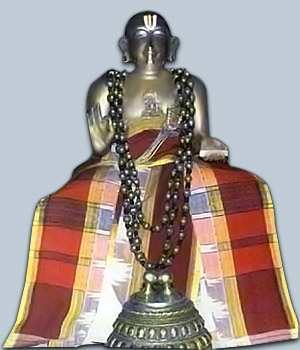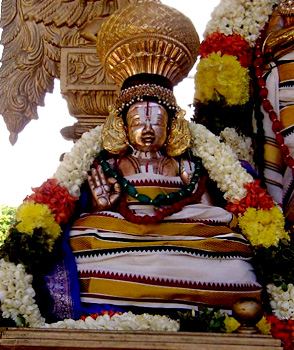 Development of Vaishnavism during the period of Vedanta Desika and Pillailokacharya marks the second and more significant development of Vaishnavism in the post-Ramanuja period. A major part of the works comes from Vedanta Desika, also known as Venkatanatha (A.D. 1268-1369), an illustrious successor to Ramanuja. In fact, his advent marks an outstanding milestone in the history of both the Visistadvaita Vedanta and Vaishnava theology. He was an intellectual and a distinguished scholar of almost all branches of traditional learning (sarvatantra-svatantra). He wrote more than 100 works covering practically all aspects of the Visistadvaita Philosophy and Religion. He wrote both in Sanskrit language and also in the Manipravala language which had become popular in his time. The philosophical works written in Sanskrit are: Tattva-mukta-kalapa with his own commentary known as Sarvarthasiddhi, Adhikarana-saravail, Nyaya-siddhanjana, Nyaya-parisuddhi, Sattadusani, Tattvatika, an incomplete commentary on Sri bhasya, Tatparya candrika (glossary on Gita bhasya), Mimdriisa paduka, Sesvara-mimamsa, Isa vasyopanisad-bhasya, Gadyatraya-bhasya (commentary on three gadyas of Ramanuja) Stotraratna-bhasya, Chatusloki bhasya (commentary on two of Yamunacharya`s lyrics) and Gitartha.-sangraha-raksa (commentary on Yamunacharya`s work on the Gita).
Development of Vaishnavism during the period of Vedanta Desika and Pillailokacharya marks the second and more significant development of Vaishnavism in the post-Ramanuja period. A major part of the works comes from Vedanta Desika, also known as Venkatanatha (A.D. 1268-1369), an illustrious successor to Ramanuja. In fact, his advent marks an outstanding milestone in the history of both the Visistadvaita Vedanta and Vaishnava theology. He was an intellectual and a distinguished scholar of almost all branches of traditional learning (sarvatantra-svatantra). He wrote more than 100 works covering practically all aspects of the Visistadvaita Philosophy and Religion. He wrote both in Sanskrit language and also in the Manipravala language which had become popular in his time. The philosophical works written in Sanskrit are: Tattva-mukta-kalapa with his own commentary known as Sarvarthasiddhi, Adhikarana-saravail, Nyaya-siddhanjana, Nyaya-parisuddhi, Sattadusani, Tattvatika, an incomplete commentary on Sri bhasya, Tatparya candrika (glossary on Gita bhasya), Mimdriisa paduka, Sesvara-mimamsa, Isa vasyopanisad-bhasya, Gadyatraya-bhasya (commentary on three gadyas of Ramanuja) Stotraratna-bhasya, Chatusloki bhasya (commentary on two of Yamunacharya`s lyrics) and Gitartha.-sangraha-raksa (commentary on Yamunacharya`s work on the Gita).
Through these works he strengthened the Visistadvaita Philosophy on a solid ground. The Rahasyatraya-sara and thirty three other Rahasya granthas written in Manipravala language strengthened the theological and esoteric doctrines of Srivaishnavism. The Pahcaratraraksa written in Sanskrit vindicated the unquestionable validity of the Pancaratra Agamas. The Saccaritraraksa has given a meaningful significance to the religious practices of Vaishnavas. The Nikseparaksa, a treatise on Sarandgati, has provided a strong defence for the practice of self-surrender to God as the sadhana for moksha. His commentary on Yamunacharya`s Chatusloki and Stotraratnam has upheld the theological concepts of the Supremacy of Vishnu over other deities and that Goddess Laxmi is an integral part of the Ultimate Reality. Through his Dramidopanisad-tatpayaratnavali and Dramidopanisad-sara, the hymns of Nammalvar secured a respectful place in the philosophical realm. His allegorical drama known as Sahkalpsuryodaya; the poetical works: Yadavdbhayu-daya and Hamsasandesa and several devotional lyrics and Padukasahasra (1000 verses on the sandals of the Lord Rahganatha), apart from exhibiting his poetic skill, are full of philosophical significance.
Thus, in the hands of Vedanta Desika, Srivaishnavism- its philosophy, theology and religious discipline- as expounded by his spiritual master, Ramanuja, got further strengthened and developed. In fact, the works which, were contributed by his predecessors, who were immediate successors to Ramanuja, were almost eclipsed.
This remarkable development of Vaishnavism through the scholarly works of Vedanta Desika was further supplemented by the contribution of Pillai Lokacharya (A.D. 1264-1369). He wrote a total of eighteen works in Manipravala language which are collectively called Astadasa-rahasya. The major works which deal with the essentials of Vaishnavism are Tattvatraiyam, Sri-vachanabhusanam, Arthapancakam and Mumuksuppadi. His other works are relatively of minor character as they deal with the esoteric doctrines (rahasyas) of Vaishnavism.
Some of Pillai Lokacharya `s views differ from those of Vedanta Desika on certain theological issues such as the ontological status of Goddess Sri, the nature of prapatti as a means to mokhsa, the operation of God`s grace vis-a-vis human endeavour, concept of vatsalya and the observance of vamasramadharma by persons engaged in divine service.
Besides, there are few other minor doctrinal differences between the two acharyas which seem to have erupted at an academic level, involving the interpretation of certain basic concepts.
 Pillai Lokacharya was a senior contemporary of Vedanta Desika and as two scholars, they were on friendly terms and bore no animosity to each other. At this stage there was no split in the Srivaishnava community into two sects as Vadakalai and Tenkalai, although the seeds of rift might have been sown. It became pronounced at a later period long after the advent of Varavaramuni, popularly known as Mana-valamamuni. The split into two sects, each claiming an allegiance to a particular acharya might have arisen much later, presumably in the eighteenth century on account of the rivalry caused by the temple administration at Srirangam which was at that time in the hands of the successors of Manavalamarnuni. The terms Vadakalai and Tenkalai literally mean Northern culture and southern culture. But they bear a different implication. The Vadakalais are those who lay greater emphasis on the Vedanta texts in Sanskrit language and the Tenkalais are those who give more prominence to the hymns of the Alvars in Tamil. However, in actual practice the Vedakalais are those Vaishnavas who owe their allegiance to Vedanta Desika, whereas Tenkalais are those who trace their allegiance to Manavalamarnuni. The distinction between the two is based on the doctrinal differences on a few theological issues. There are eighteen points of difference some of which are of major significance while many are of minor importance.
Pillai Lokacharya was a senior contemporary of Vedanta Desika and as two scholars, they were on friendly terms and bore no animosity to each other. At this stage there was no split in the Srivaishnava community into two sects as Vadakalai and Tenkalai, although the seeds of rift might have been sown. It became pronounced at a later period long after the advent of Varavaramuni, popularly known as Mana-valamamuni. The split into two sects, each claiming an allegiance to a particular acharya might have arisen much later, presumably in the eighteenth century on account of the rivalry caused by the temple administration at Srirangam which was at that time in the hands of the successors of Manavalamarnuni. The terms Vadakalai and Tenkalai literally mean Northern culture and southern culture. But they bear a different implication. The Vadakalais are those who lay greater emphasis on the Vedanta texts in Sanskrit language and the Tenkalais are those who give more prominence to the hymns of the Alvars in Tamil. However, in actual practice the Vedakalais are those Vaishnavas who owe their allegiance to Vedanta Desika, whereas Tenkalais are those who trace their allegiance to Manavalamarnuni. The distinction between the two is based on the doctrinal differences on a few theological issues. There are eighteen points of difference some of which are of major significance while many are of minor importance.
Thus at the religious level Vaishnavism grew on two parallel lines in the later centuries as a result of the sectarian differences. But at the philosophical level, however, Visistadvaita Vedanta as expounded by Ramanuja has continued unaffected by these differences.









